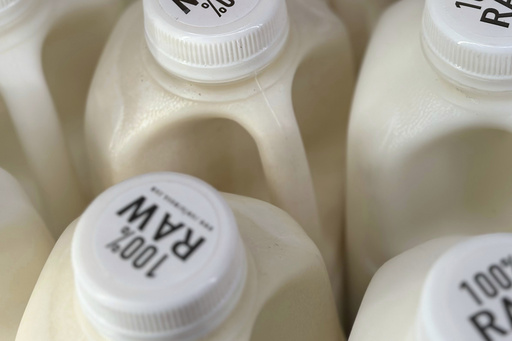
President-elect Donald Trump’s selection for the country’s leading health position, Robert F. Kennedy Jr., has pledged to expand access to raw milk throughout the United States. However, the recent discovery of the bird flu virus in unpasteurized milk sold in California highlights the health risks associated with consuming raw milk, according to health experts.
“One must be aware that raw milk, or unpasteurized milk, potentially harbors infectious agents that could lead to serious illnesses for those who consume it,” stated Michael Osterholm, an infectious disease researcher at the University of Minnesota, who has studied foodborne outbreaks.
Raw Farm LLC from Fresno, California, has voluntarily pulled one batch of its “cream top” whole raw milk off the shelves after health officials in Santa Clara County detected the bird flu virus in a sample last week. The state’s health department indicated that the county has been sampling raw milk for safety, serving as an additional safeguard for consumers.
While no reported illnesses have been linked to Raw Farm’s products—which carry lot code 20241109 with a best-by date of November 27—officials from California’s health department urged consumers to refrain from drinking the milk and instructed retailers to remove it from their inventory. On Tuesday, health authorities in Los Angeles County cautioned that “many retail locations” may have distributed the recalled raw milk infected with the virus.
Here’s what additional information is crucial regarding raw milk and the bird flu virus:
What is known about the relationship between bird flu and milk?
According to Osterholm, the discovery of the virus in commercially sold raw milk is not unexpected. The bird flu, scientifically categorized as Type A H5N1 influenza, was first reported in U.S. dairy cattle in March and has since spread extensively. In California, infection rates have affected over 435 dairy herds, surpassing cases in all other states combined. Furthermore, significant traces of the virus have been identified in the milk of infected dairy cows.
Surveys conducted earlier this year revealed that around 20% of samples of pasteurized milk sold in retailers contained viral remnants of the bird flu virus. Pasteurization, which involves heating milk, effectively eliminates not only the bird flu virus but also other harmful bacteria such as E. coli, listeria, and salmonella that can cause illness in humans.
The California Department of Food and Agriculture has been routinely testing raw milk in bulk tanks from statewide dairies on a weekly basis. While additional tests at Raw Farm locations returned negative results for the virus, officials announced they would increase testing for bird flu to twice a week.
Given that limited tests on unpasteurized milk products from retailers have been performed, Osterholm remarked that other raw dairy items might still carry the virus. He emphasized the lack of comprehensive testing, noting, “We are operating without adequate data.”
Can raw milk contaminated with bird flu pose a risk to human health?
As of now, there is no confirmation that individuals have contracted the bird flu virus from consuming raw milk. This year, at least 55 cases of infection have been documented in the U.S., primarily among dairy and poultry farm workers who exhibited mild symptoms after direct contact with infected animals.
Research has indicated that rodents fed raw milk contaminated with the bird flu experienced severe illness, and farm cats that consumed milk from infected cows suffered brain damage and died, according to Nicole Martin, microbiologist and associate director of Cornell University’s Milk Quality Improvement Program.
“The risk of H5N1 transmission to people through raw milk consumption remains uncertain; however, current evidence suggests a need for heightened caution,” Martin remarked.
What is the raw milk consumer demographic?
Approximately 4.4% of U.S. adults, equating to about 11 million individuals, consume raw milk at least once a year, while roughly 1% report weekly consumption, according to a 2022 FDA survey.
Supporters of raw milk often emphasize its perceived health benefits and superior taste as primary motivations for its consumption. Raw Farm promotes its offerings as “unprocessed and complete”, highlighting vitamins, minerals, enzymes, and beneficial bacteria.
Kennedy, a notable advocate, has expressed his preference for raw milk and criticized regulatory measures aimed at limiting its availability. He promised that the Food and Drug Administration’s stringent stance on unpasteurized milk would be relaxed under his watch.
Mark McAfee, the owner of Raw Farm, has been featured prominently on podcasts hosted by Nicole Shanahan, who was previously Kennedy’s running partner; both are among the customers of McAfee’s products. “They desire that same caliber of distinguished, exquisite, tested, safe, delicious raw milk for everyone,” McAfee stated.
What insights do health authorities provide about raw milk?
Health officials have consistently cautioned that consuming raw milk may lead to ailments ranging from mild to life-threatening. Between 1998 and 2018, the U.S. Centers for Disease Control and Prevention identified over 200 illness outbreaks tied to raw milk, affecting more than 2,600 individuals, with over 225 requiring hospitalization.
Prior to the establishment of safety standards in 1924, referenced as the Pasteurized Milk Ordinance, dairy consumption was linked to approximately 25% of foodborne illnesses, as reported by the Center for Dairy Research. Presently, dairy products account for roughly 1% of such cases.
